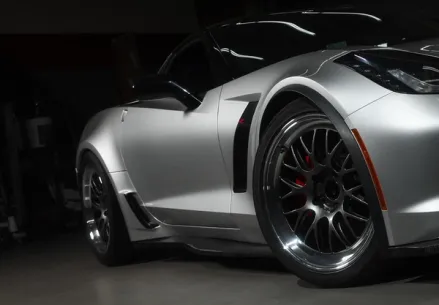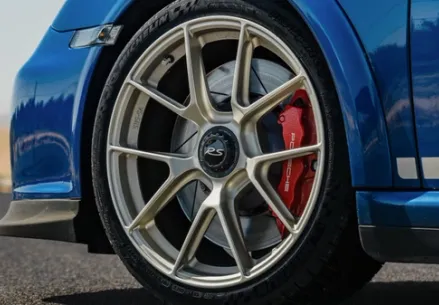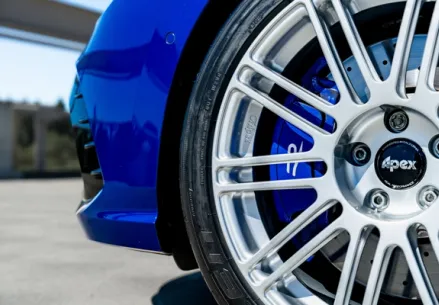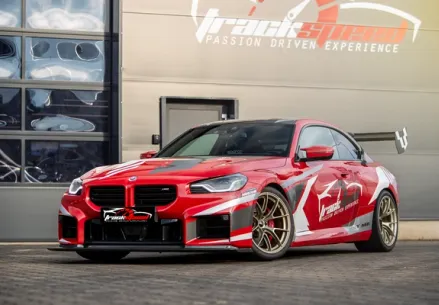
18″ vs 19″ Wheels, Which Is Right For You?
Article | 08/30/2019 by Cory Smetzler
Updated on 08/06/2024
The APEX staff gets asked this question daily, and our answer is always the same: our recommendation fully depends on the modifications you currently have or plan to get, how you intend to use the car, as well what you are looking to achieve by installing aftermarket wheels. I will start out this article with the following disclaimer. Every vehicle is unique, and if you have any lingering questions when you’re done reading, feel free to reach out to one of our Product Experts for more guidance.
Around the start of this decade, you wouldn’t even be reading an article like this. 18” wheels (and 17” for many) had been the go-to without question. All of the major tire manufacturers had an endless supply of “the right” sizes for your car, and 18” wheels fit over even the largest brake kits fitted to cars rolling off the assembly line. 19” tires were also hard to come by, and the sizes you did find were outrageously expensive. However, in the last 4-5 years the market has seen a dramatic shift. The Pony Car wars are bigger and better now than they ever were in the 1960s. Mustangs are coming from the factory with brake rotors exceeding the diameter of some factory wheels produced back in the day. Change happens and progress is expected and welcomed. The situation we now face today is actually a good problem to have. There is currently a vast assortment of tire options available in both 18” and 19” sizes. In most cases, this means there is no wrong choice.
When deciding on what size wheel to run, we believe you should first determine what tire you would like to use and how you will use it. (1) Do you want a tire to cruise on the street comfortably but also rip up the mountains on the weekends? (2) What about a tire for heavy track use that sees little to no street use? (3) Or how about a tire that can tear up the track on Sunday, and drive you to work on Monday?
This is a question you must answer for yourself.
If you fall under the first category, you’re in luck! You cannot go wrong with either 18s or 19s as there is an abundance of tires available for this use. 18×9.5”, 18×10”, and 19×10” all have lots of tire options in the 275/40-18 to 285/35-19 range which works great on the street. Be careful of going with a staggered setup that has 11” rear tires, as it is difficult to find tires that match the desired front sizes that are both wide enough and tall enough. A few of our favorites in this segment are the Michelin Pilot Sport 4S, Continental ExtremeContact Sport, and the Falken FK510.

For someone who finds themselves in the second category, the 18” catalog has a lot more suitable offerings. Many race-oriented tires come in 18” sizes, and while there are some in 19”, the selection has fewer options, and they tend to be more expensive. Continental and Pirelli offer a lot of slicks, and Hoosier makes their renowned R7 and A7 in plenty of 18” sizes. People who are in this category are also likely to care a lot more about weight than the other two would. 18” wheels will always be lighter than their 19” counterparts. 18” wheels and tires are also more affordable than their 19” counterparts, which helps a lot with yearly consumable costs.

The third category of tires is one that has evolved a lot in the last few years, and this is where the 200 TW tires fall. Some of today’s top tier 200TW tires are the Falken RT660 and BFG Rival S 1.5. They are wicked fast tires that also have decent street manners, making them an excellent choice for someone who doesn’t want to mess around with multiple sets of wheels/tires but still wants to get the most performance out of their car. For these people, a 19” tire has a much better selection available for modern day Mustangs. 275/35-19, 285/35-19, and 305/30-19 have essentially every major tire you could ask for. The go-to wheel size in this scenario would be 19×10” ET40 square or 19×11” ET52 square. You could also run a 10”/11” stagger, however Mustangs prefer square setups for more balanced handling and less understeer.

Something to keep in mind, the 2011-2017 Mustang GT’s equipped with a manual transmission and 3.73 rear gears rely on a taller rear tire to help with their aggressive ratio from the factory. Often times I see many people running 25-26” tires on these particular cars, and they’re complaining about overheating or never seeming to be in the correct gear. Unfortunately, there is no way around this. If you love your tire and refuse to change it, the best way to fix the problem is to change the rear gears out for 3.31 or 3.55.
Now, if you’re the kind of person who doesn’t mind the tire selections offered for a given wheel size and are open to making anything work, yet are still unsure as to what to get, please continue reading.
“I prefer 19” wheels because it fills out the wheel well better”
This is another statement we often hear. While visually this could be true with certain wheel designs, wheel diameter does not dictate overall tire height, and the tire is what will actually “fill out the wheel well”, as they say. Let’s take our EC-7 18×11” ET52 fitted with a 305/35-18 Nitto NT-01 for example and compare it to the EC-7 19×11” ET52 with a 305/30-19 NT-01. The 305/35-18 is listed at 26.42” in diameter, while the 305/30-19 is listed at 26.26” in diameter. In this scenario, the corresponding 18” tire is actually larger and will thus occupy more room in the wheel well. Why did I choose these particular tires? For starters, they are both very common track setups that perform exceptionally well. They also have the same section width at 12.32” so they are incredibly similar tires in overall dimensions.

“Do lighter wheels make my car faster?”
This is a very subjective topic, and certain magazines have performed “tests” with varying results. Anytime you can reduce weight from a vehicle it is a good thing. Less weight means quicker acceleration, shorter braking distances, and more responsive handling. Will you notice a reduction in lap times from lighter wheels? It is hard to say exactly, as often times lighter wheels are combined with wider and stickier tires. Anyone that has experienced lightweight wheels however, can tell you that it is a noticeable difference in feel with those attributes we listed earlier. Since rotating mass is roughly 3 times harder to accelerate than sprung mass, dropping 5 pounds per corner from lighter wheels would be equivalent to removing 60 pounds from the interior of your vehicle. Now that is noticeable!

Money meets the road
Everyone has a budget, it’s part of life. Tires are a consumable and an expensive one at that. Our 18×11” EC-7 has an MSRP of $414 while the 19×11” EC-7 has an MSRP of $484. A 305/35-18 NT-01 costs $393 on Discount Tire Direct while a 305/30-19 NT-01 costs $500 on the same site. What does this mean over the course of a season? Assuming the average track enthusiast goes through two sets of tires, and including the initial cost of purchasing wheels, the breakdown can be seen below.
(4) 18×11” ET52 EC-7 at $414 ea = $1,656 (8) 305/35-18 Nitto NT-01 at $393 ea = $3,144 Total (not including taxes, shipping, mounting, etc) = $4,800
(4) 19×11” ET52 EC-7 at $484 ea = $1,936 (8) 305/30-19 Nitto NT-01 at $500 ea = $4,000 Total (not including taxes, shipping, mounting, etc) = $5,936
While all prices are subject to change, there is a significant price difference across the span of the year. These savings can be applied to other consumables such as brakes or fuel expenses.
With all the different options out there, it can be overwhelming at times when trying to choose a wheel and tire package for your ride. Hopefully this article reduces some of the stress involved and makes the decision much simpler. As always, don’t hesitate to reach out to us through our one-on-one fitment recommendation form.
Pick up a set of wheels for your Ford Mustang today, click here to shop
Tags
 Cory Smetzler
Cory SmetzlerCory has been Domestic Fitment Expert at APEX since 2018, helping owners figure out the proper wheel fitments for their Camaro, Corvette, Mustang, Challenger, Charger, Cadillac, and Tesla vehicles. Prior to joining APEX, he worked as Service Advisor at an automotive performance shop. Never one to sit at a car show, Cory has had a lifelong passion for performance driving. His extensive track experience began with HPDEs in 2015. He soon got the itch to start competing in time trials, which he has been doing ever since. Among the cars he has tracked are three Mustang GTs (2005, 2006, 2011), a 2016 Fiesta ST, and his current ride, a 2010 Corvette Grand Sport with APEX SM-10RS wheels. Fun Fact: Apparently Cory’s love of speed isn’t limited to the racetrack; after not training at all, he recently ran a 5K and placed 7th out of 210 competitors.
Have questions about wheels for your domestic vehicle? Use our contact form and ask for Cory
If you like cheap gear you will hate this newsletter.





